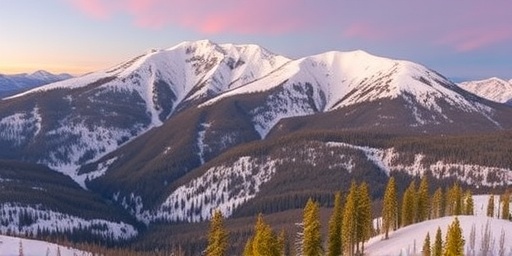In a stark warning for winter enthusiasts and water managers alike, scientists have revealed that Colorado’s iconic ski seasons could shrink by as much as 10 days in the coming decades, driven by climate change and increasing weather variability in the state’s Snowpack. This shift, detailed in a new study from the University of Colorado Boulder, points to a Snowpack becoming wetter and less predictable, threatening not just downhill thrills but also the vital water supplies that sustain millions across the Western U.S.
- New Study Uncovers Wetter, Unpredictable Snowpack in Colorado Rockies
- Ski Industry Faces Mounting Challenges from Shortened Seasons and Variable Conditions
- Water Supplies at Risk: How Colorado’s Snowpack Shift Affects the Western U.S.
- Climate Models Paint Dire Picture: Experts Call for Urgent Action
- Looking Ahead: Strategies to Safeguard Skiing and Water in a Changing Climate
The research, published in the journal Water Resources Research, analyzed decades of climate models and historical data, showing how rising temperatures are altering the very composition of mountain snow. What was once a reliable blanket of dry, powdery snow is evolving into denser, moisture-laden layers that melt faster under warmer conditions. ‘We’re seeing a fundamental change in how snow accumulates and persists,’ said lead researcher Dr. Nora McDowell, an environmental scientist at CU Boulder. ‘This isn’t just about shorter ski days—it’s a ripple effect across ecosystems and economies.’
New Study Uncovers Wetter, Unpredictable Snowpack in Colorado Rockies
At the heart of the concern is the evolving nature of Colorado’s snowpack, the seasonal accumulation of snow in the Rocky Mountains that serves as both a recreational draw and a natural reservoir. Traditional snowpack in the region has been characterized by light, fluffy flakes ideal for skiing, but recent observations indicate a trend toward wetter snow due to warmer air temperatures trapping more moisture during storms.
According to the study, which drew on data from over 800 snow monitoring stations across Colorado, average snowpack depth has remained relatively stable in some areas, but its quality has deteriorated. Wetter snow means higher liquid water content—up to 20% more in recent winters compared to the 1980s—leading to quicker runoff when temperatures rise. This weather variability is exacerbated by climate change, with erratic storm patterns delivering intense but shorter precipitation events rather than steady snowfall.
Climate models project that by mid-century, under moderate emissions scenarios, Colorado’s high-elevation snowpack could see peak accumulation dates shift earlier by two weeks, compressing the window for sustained cold weather. ‘The variability is the real killer,’ explained co-author Dr. Jeremy Williams, a hydrologist with the U.S. Geological Survey. ‘One year we might have record snow, the next a drought-like winter. This unpredictability makes planning impossible for everyone from ski operators to farmers.’
To illustrate the scale, the researchers used ensemble modeling from the Coupled Model Intercomparison Project (CMIP6), simulating thousands of future scenarios. In one alarming projection, the effective ski season—defined as periods with at least 30 inches of base snow and temperatures below freezing—could shorten from the current 120 days to just 110 by 2050. This isn’t hyperbole; historical trends already show a 5-day reduction since the 1970s, aligning with broader patterns of climate change in the West.
Ski Industry Faces Mounting Challenges from Shortened Seasons and Variable Conditions
Colorado’s ski industry, a powerhouse generating over $4.5 billion annually and supporting 50,000 jobs, stands on the front lines of this transformation. Resorts like Vail, Aspen, and Breckenridge, which attract 13 million visitors each winter, rely on consistent snowpack for their operations. A 10-day shave off the ski season could translate to millions in lost revenue, as peak weeks in December and March drive the bulk of profits.
Industry leaders are already feeling the pinch. ‘We’ve invested heavily in snowmaking, but it’s no silver bullet against climate change,’ said Rob Perlman, president of Vail Resorts. In the 2022-2023 season, for instance, unseasonably warm spells forced early closures at several Colorado resorts, costing an estimated $100 million statewide. Wetter snowpack compounds the issue, as it compacts more easily, reducing the fluffy base that skiers crave and increasing avalanche risks in variable weather.
Weather variability adds another layer of complexity. Sudden thaws followed by refreezes create icy conditions, deterring casual visitors and boosting injury rates. A report from the National Ski Areas Association highlights that 70% of Colorado resorts now use artificial snow to extend seasons, but this requires vast amounts of water—up to 200 gallons per skier per day—and energy, raising sustainability questions. Smaller, independent hills are hit hardest, with some facing closure if snowpack reliability continues to wane.
Beyond economics, the cultural impact is profound. Skiing in Colorado isn’t just a sport; it’s a way of life, woven into the state’s identity. Families pass down traditions of powder days, and communities thrive on winter festivals. As seasons shorten, experts warn of a potential exodus of young talent to snow-surer destinations like the Alps or even domestic spots in Utah, where higher elevations might buffer some effects longer.
- Key Statistic: Colorado ski visits dropped 15% in warm winters like 2012 and 2020.
- Adaptation Example: Breckenridge Resort has expanded summer operations, including mountain biking, to offset winter shortfalls.
- Visitor Feedback: Surveys show 60% of out-of-state skiers cite snow reliability as their top concern.
Water Supplies at Risk: How Colorado’s Snowpack Shift Affects the Western U.S.
The implications extend far beyond the slopes, striking at the core of water security for the arid West. Colorado’s snowpack acts as a massive freshwater bank, slowly releasing meltwater to feed the Colorado River, which supplies 40 million people and irrigates 5.5 million acres of farmland across seven states. Wetter, more variable snowpack means faster melting, potentially overwhelming rivers in spring and leaving shortages by summer.
Historical data from the Natural Resources Defense Council indicates that snowmelt contributes 70% of the Colorado River’s flow. With climate change accelerating melt rates—up 15% since 2000 in some basins—reservoirs like Lake Powell and Lake Mead are at historic lows, triggering water cuts for Arizona, Nevada, and California. The new research forecasts that by 2040, peak snowmelt could arrive 10-15 days earlier, desynchronizing it with agricultural demands and urban needs.
‘This is a slow-motion crisis,’ noted Amy McNamara, a water policy expert at the University of Arizona. ‘Variable snowpack means boom-and-bust hydrology: floods one year, droughts the next.’ In Colorado alone, the state provides water to downstream users via compacts dating back to 1922, but increasing weather variability could strain these agreements, sparking legal battles over allocations.
Ecosystems are also vulnerable. Wetlands and riparian habitats dependent on steady snowmelt face drying, threatening species like the endangered humpback chub in the Grand Canyon. Agriculture, which uses 80% of the region’s water, could see crop yields drop by 20% in dry years, per USDA projections, hitting staples like alfalfa and cotton.
- Current Lows: Colorado River flows have declined 20% since 2000 due to warmer temperatures.
- Future Projections: Models predict a 30% reduction in snowpack water storage by 2100 under high-emissions paths.
- Mitigation Efforts: States are exploring groundwater recharge and conservation mandates to buffer variability.
Climate Models Paint Dire Picture: Experts Call for Urgent Action
Underpinning the warnings are sophisticated climate models that integrate atmospheric data, satellite imagery, and ground observations to forecast snowpack behavior. The University of Colorado’s study leveraged the Variable Infiltration Capacity (VIC) model, which simulates snow accumulation, melt, and runoff at a 1/16th-degree resolution across the Rockies. Results consistently show that even aggressive emissions reductions might only limit the ski season loss to 5-7 days, underscoring the inertia of climate change.
Experts like Dr. McDowell emphasize the role of weather variability as a multiplier. ‘It’s not just warmer; it’s wilder,’ she said in a recent interview. Oscillations like El Niño and La Niña, amplified by global warming, could swing Colorado’s snowfall by 30% year-to-year, making long-term planning a gamble. The Intergovernmental Panel on Climate Change (IPCC) corroborates this, noting that mid-latitude snowpacks worldwide are projected to decline 10-40% by century’s end.
Interviews with meteorologists reveal a consensus: without curbing greenhouse gases, Colorado’s snow-dependent economy could lose $1 billion annually by 2050. Quotes from the field abound—’We’ve hit the tipping point’ from a Steamboat Springs ski patrol veteran, or ‘Innovation must match the pace of change’ from a Telluride resort owner. Policymakers are listening; the Colorado Water Conservation Board has allocated $50 million for snowpack monitoring tech, including AI-driven forecasts to predict variability.
Yet challenges persist. Funding for research lags behind needs, and political divides hinder federal action on climate change. As one anonymous scientist put it, ‘The data is clear, but denial delays adaptation.’
Looking Ahead: Strategies to Safeguard Skiing and Water in a Changing Climate
As the reality of shorter ski seasons and erratic snowpack sets in, stakeholders are pivoting toward resilience. For the ski industry, diversification is key: resorts are enhancing year-round appeal with zip lines, music festivals, and eco-tourism, while investing in efficient snowmaking using recycled water. Vail Resorts, for example, aims to cut its carbon footprint by 50% by 2030 through renewable energy and reforestation.
On the water front, innovative solutions like cloud seeding—spraying silver iodide into storms to boost snowfall—show promise, with trials in Colorado increasing precipitation by 10-15% in targeted areas. Interstate collaborations, such as the Colorado River Basin Drought Task Force, are fostering shared reservoirs and demand management, including fallowing fields during shortages.
Broader societal shifts are underway too. Urban planners in Denver and beyond are promoting water-efficient landscaping and greywater systems to reduce reliance on snowmelt. Education campaigns aim to build public awareness, encouraging behaviors like reduced meat consumption to lower emissions driving climate change.
Ultimately, the path forward demands collective action. Scientists urge immediate emissions cuts to stabilize weather variability, while local governments push for resilient infrastructure. ‘We can still ski Colorado’s peaks and secure its waters, but only if we act now,’ Dr. Williams concluded. With the 2024 ski season approaching, the stakes feel higher than ever, blending hope with the urgency of a warming world.









